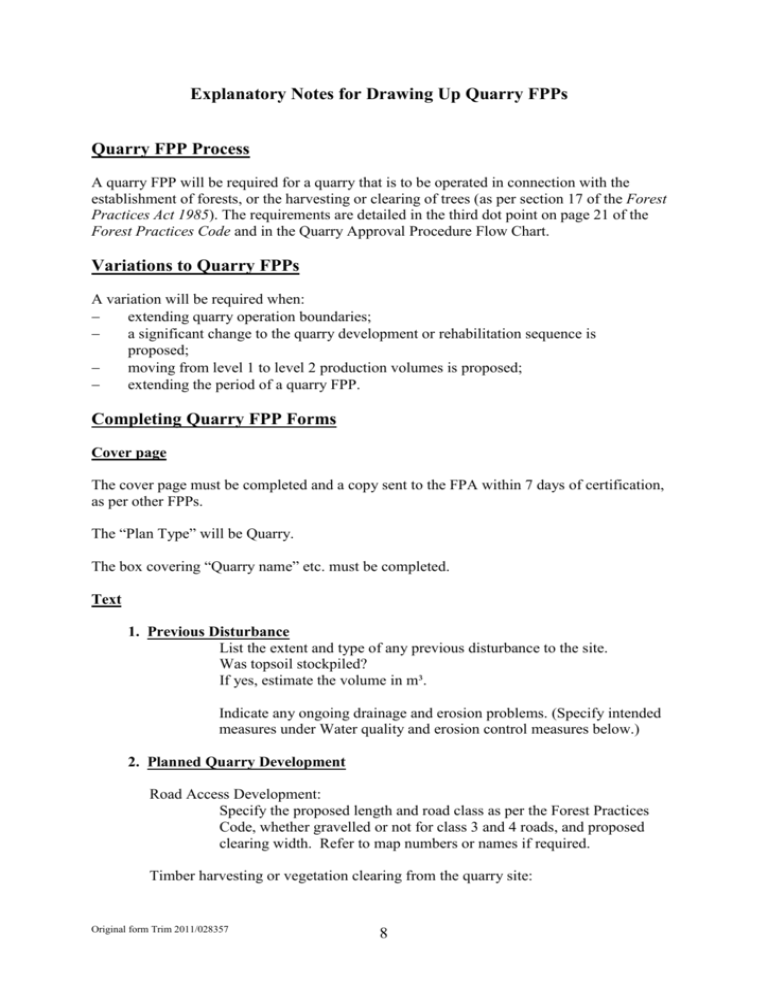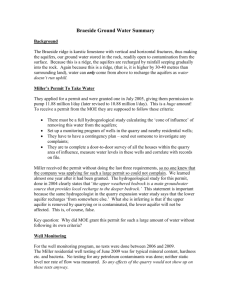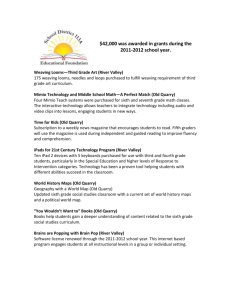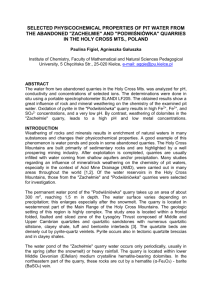Explanatory Notes for Drawing Up Quarry FPPs
advertisement

Explanatory Notes for Drawing Up Quarry FPPs Quarry FPP Process A quarry FPP will be required for a quarry that is to be operated in connection with the establishment of forests, or the harvesting or clearing of trees (as per section 17 of the Forest Practices Act 1985). The requirements are detailed in the third dot point on page 21 of the Forest Practices Code and in the Quarry Approval Procedure Flow Chart. Variations to Quarry FPPs A variation will be required when: extending quarry operation boundaries; a significant change to the quarry development or rehabilitation sequence is proposed; moving from level 1 to level 2 production volumes is proposed; extending the period of a quarry FPP. Completing Quarry FPP Forms Cover page The cover page must be completed and a copy sent to the FPA within 7 days of certification, as per other FPPs. The “Plan Type” will be Quarry. The box covering “Quarry name” etc. must be completed. Text 1. Previous Disturbance List the extent and type of any previous disturbance to the site. Was topsoil stockpiled? If yes, estimate the volume in m³. Indicate any ongoing drainage and erosion problems. (Specify intended measures under Water quality and erosion control measures below.) 2. Planned Quarry Development Road Access Development: Specify the proposed length and road class as per the Forest Practices Code, whether gravelled or not for class 3 and 4 roads, and proposed clearing width. Refer to map numbers or names if required. Timber harvesting or vegetation clearing from the quarry site: Original form Trim 2011/028357 8 Specify the area to be cleared of vegetation, and how the boundary of the clearing is to be determined or marked. State what is to happen to the vegetation debris cleared from the site. Planned sequence of operation: Describe how the site is to be operated including the sequence (timing) of each major activity. Maximum anticipated bench/face height: Specify the maximum bench/face height, e.g. three steps of 5m each. Estimated life of quarry: Estimate the life of the quarry in years. 3. Conservation of Natural and Cultural Values Include prescriptions to manage, avoid or minimise disturbance to flora, fauna, geomorphic, cultural heritage, landscape, and soil and water values. The process for completion of Natural and Cultural Values Evaluation Sheets is the same as for other types of FPPs. The final agreed prescriptions for natural and cultural values must be included in the FPP. Flora: Include prescriptions to manage flora values, including communities and species of high conservation significance, and to manage weeds (see the Tasmanian Washdown Guidelines for Weed and Disease Control). Fauna: Specify measures to protect species of high conservation significance. Geoscience: Specify measures to be taken to protect or manage significant landforms present, including geoconservation sites. Cultural Heritage: Specify requirements for undertaking surveys for Aboriginal sites where appropriate. Specify measures to be taken to protect or manage significant sites. Landscape: Describe how the landscape management objective will be achieved. Need to address the close proximity impact if there are local residences or passing traffic. 4. Other Environmental Prescriptions Noise: Need to address the close proximity impact if there are local residences or passing traffic. Include consideration of blasting (times & conditions). Original form Trim 2011/028357 9 Dust: Need to address the close proximity impact if there are local residences or passing traffic. Distance to nearest house: Specify the distance of the closest point of the quarry to the nearest house (to the nearest 100 metres if closer than 1km). If closer than 1km, residents and local government should be consulted regarding the management of noise, dust and visual impact (as appropriate). Truck movements which may affect the public: Include the permitted hours of truck movements (consider other traffic e.g. school buses), and the likely number of truck movements per day. List the public roads to be used and the likely periods of use. Phytophthora management: (Refer to Flora Technical Note No. 8 – Management of Phytopthora cinnamomi in Production Forests and to the Tasmanian Washdown Guidelines for Weed and Disease Control.) It is important that quarries are well managed so that Phytophthora is not brought into uncontaminated quarries, and material contaminated with Phytopthora is not taken from quarries to uncontaminated sites. Refer to the above Technical Note for appropriate controls and prescriptions. Water quality and erosion control measures: Describe the type and placement of sediment and drainage control structures, and their maintenance, e.g. catch drains around the top side of the quarry, silt traps. 5. Planned Rehabilitation Procedures Describe the rehabilitation measures to be incorporated progressively and at final site restoration. Rehabilitation should result in a stable site that is well drained and not eroding. Vegetation cover will normally be required to achieve this and to reduce the long term visual impact. Soil re-spreading depth: Specify the intended thickness of top soil to be spread as part of the rehabilitation process. Proposed revegetation activities: Specify species and source of seed or planting stock, and planting rate or distribution. Specify the requirements for monitoring of revegetation. 6. Map/Site Plan (i) Locality map: A locality map (generally at 1:25,000) is required to place the quarry site in context with the surrounding area and features. (ii) Site plan: This is a detailed plan of the quarry site showing the proposed location of quarry activities and features. Original form Trim 2011/028357 10 (iii) Cross section(s): Include cross section diagrams (generally two at right angles to each other) showing the profile of the quarry at commencement of the plan and after final rehabilitation. A three dimensional drawing may be desirable in some circumstances to clarify how the quarry is to be operated. Signatures Acknowledgement forms must be completed as per other FPPs (the quarry manager can sign Acknowledgement Form 2). Each page of the FPP, including maps and site plans, should be initialled and dated by the landowner, applicant and certifying FPO. Only an FPO with specific authority from the FPA to certify quarry FPPs may certify the plan. CM 28/5/07 Original form Trim 2011/028357 11





